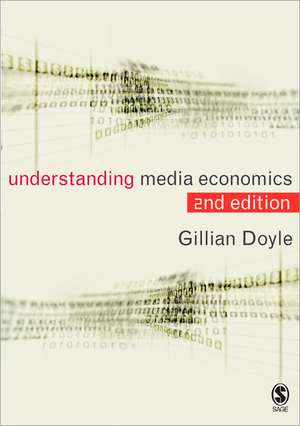Understanding Media Economics
Autor Gillian Doyleen Limba Engleză Paperback – 17 apr 2013
- Lucy Küng, Oxford University and Jonkoping University
"A wide-ranging, accessible introduction to media economics and their application to a broad range of media topics from advertising and business models to copyright, audience demand and public policy."
- Chris Bilton, University of Warwick
"An excellent textbook on media economics, which takes into account the full complexity of the subject matter in the context of structural, technological and creative transformations that characterise digital media."
- Milan Todorovic, London Metropolitan University
With the rapidly evolving digital media landscape, this second and completely revised edition of Understanding Media Economics moves beyond a sector-specific approach to media analysis, and instead focuses on the issues and imperatives that are now central to how economic forces impact on the media industries. Exploring themes such as innovation, digital multi-platform developments, the emerging importance of networks, branding and segmentation of market demand, strategies of risk-spreading, maximizing value within content, intermediation and rights management, corporate expansion and advertising, this book addresses and explains the key pressing questions and issues that are transforming contemporary media industries and markets.
Gillian Doyle makes the economics of the media fascinating, compelling and easy to understand. This is essential reading for students of media economics, media management, media policy and courses across the cultural and creative industries.
| Toate formatele și edițiile | Preț | Express |
|---|---|---|
| Paperback (1) | 350.31 lei 3-5 săpt. | +23.17 lei 4-10 zile |
| SAGE Publications – 17 apr 2013 | 350.31 lei 3-5 săpt. | +23.17 lei 4-10 zile |
| Hardback (1) | 1001.47 lei 6-8 săpt. | |
| SAGE Publications – 16 apr 2013 | 1001.47 lei 6-8 săpt. |
Preț: 350.31 lei
Nou
Puncte Express: 525
Preț estimativ în valută:
67.04€ • 69.81$ • 56.66£
67.04€ • 69.81$ • 56.66£
Carte disponibilă
Livrare economică 17 februarie-03 martie
Livrare express 31 ianuarie-06 februarie pentru 33.16 lei
Preluare comenzi: 021 569.72.76
Specificații
ISBN-13: 9781412930772
ISBN-10: 1412930774
Pagini: 232
Ilustrații: black & white illustrations, black & white tables, figures
Dimensiuni: 170 x 242 x 13 mm
Greutate: 0.41 kg
Ediția:Second Edition
Editura: SAGE Publications
Colecția Sage Publications Ltd
Locul publicării:London, United Kingdom
ISBN-10: 1412930774
Pagini: 232
Ilustrații: black & white illustrations, black & white tables, figures
Dimensiuni: 170 x 242 x 13 mm
Greutate: 0.41 kg
Ediția:Second Edition
Editura: SAGE Publications
Colecția Sage Publications Ltd
Locul publicării:London, United Kingdom
Recenzii
This is an excellent textbook on media economics, which takes into account the full complexity of the subject matter in the context of structural, technological and creative transformations that characterise digital media at the start of the twenty-first century.
Milan Todorovic
London Metropolitan University
Gillian Doyle's book provides a wide-ranging, accessible introduction to media economics and their application to a broad range of media topics from advertising and business models to copyright, audience demand and public policy. Whilst critical of the certainties and simplifications of economists, Doyle delivers not only a lucid overview of economic concepts like merit goods, deficit financing and economies of scope, but shows how these continue to be relevant and useful for understanding how media work. The book is alert to the disruptive effects of technology, but highlights the continuities between old and new media, and between economic certainties and media complexity. Some of the chapters could work as self-contained extracts for a seminar or specialist module (each chapter helpfully includes a list of learning outcomes), but the book perhaps works better as a single narrative, with recurrent themes and motifs. What's refreshing about the book is Doyle's willingness to move beyond the boundaries of media economics and forge connections with a diversity of topics, policies, practices and debates. The book is generous with its expertise, covering the basics for a non-specialist and providing up to date insights from current research for more advanced readers, intercut with interviews and examples from the industry. Throughout the book Doyle's experience as a teacher shines through, a reminder that the virtues of good teaching - clear structure, avoiding jargon, questioning received wisdom and providing the resources for readers to form their own opinions rather than expounding one's own - can also inspire good research.
Chris Bilton
Centre for Cultural Policy Studies, University of Warwick
In this accessible and thoroughly up-to-date book, Gillian Doyle expertly synthesizes economic theory and contemporary cases to both explain the structure of the contemporary media industry and shed insight on the significant challenges and controversies confronting the sector. A hugely valuable resource.
Lucy Küng
Reuters Institute for the Study of Journalism, Oxford University, and Jonkoping University, Sweden
This second edition of Understanding Media Economics is a welcome overhaul that gets to the heart of the issues and challenges in today’s media industry. It is more applicable beyond the classroom than the previous version and should be on the reading lists, not just of students in media economics course, but also of many in Westminster, Brussels and Strasbourg.
Milan Todorovic
London Metropolitan University
Gillian Doyle's book provides a wide-ranging, accessible introduction to media economics and their application to a broad range of media topics from advertising and business models to copyright, audience demand and public policy. Whilst critical of the certainties and simplifications of economists, Doyle delivers not only a lucid overview of economic concepts like merit goods, deficit financing and economies of scope, but shows how these continue to be relevant and useful for understanding how media work. The book is alert to the disruptive effects of technology, but highlights the continuities between old and new media, and between economic certainties and media complexity. Some of the chapters could work as self-contained extracts for a seminar or specialist module (each chapter helpfully includes a list of learning outcomes), but the book perhaps works better as a single narrative, with recurrent themes and motifs. What's refreshing about the book is Doyle's willingness to move beyond the boundaries of media economics and forge connections with a diversity of topics, policies, practices and debates. The book is generous with its expertise, covering the basics for a non-specialist and providing up to date insights from current research for more advanced readers, intercut with interviews and examples from the industry. Throughout the book Doyle's experience as a teacher shines through, a reminder that the virtues of good teaching - clear structure, avoiding jargon, questioning received wisdom and providing the resources for readers to form their own opinions rather than expounding one's own - can also inspire good research.
Chris Bilton
Centre for Cultural Policy Studies, University of Warwick
In this accessible and thoroughly up-to-date book, Gillian Doyle expertly synthesizes economic theory and contemporary cases to both explain the structure of the contemporary media industry and shed insight on the significant challenges and controversies confronting the sector. A hugely valuable resource.
Lucy Küng
Reuters Institute for the Study of Journalism, Oxford University, and Jonkoping University, Sweden
This second edition of Understanding Media Economics is a welcome overhaul that gets to the heart of the issues and challenges in today’s media industry. It is more applicable beyond the classroom than the previous version and should be on the reading lists, not just of students in media economics course, but also of many in Westminster, Brussels and Strasbourg.
Cuprins
Chapter 1: Introduction
What Is Media Economics about?
Macroeconomics and Microeconomics
The Firm in Economic Theory
Competitive Market Structures
Market Structure and Behaviour
What Is So Special About Economics of the Media?
Key Economic Characteristics of the Media
Economies of Scale
Economies of Scope
Changing Technology
Chapter 2: Convergence and Multi-Platform
The Vertical Supply Chain
Changing Market Structures and Boundaries
Digital Convergence
Technological Change, Innovation and Creative Destruction
Multi-Platform
A New Cornucopia?
Chapter 3: Corporate Growth and Concentration Strategies
Strategic Responses to Digitization
Managerial Theories
Horizontal Expansion
Diagonal and Conglomerate Growth
Vertical Expansion
Transnational Growth
Chapter 4: Networks
Economics of Networks
Broadcasting Networks
Global Networks in Transnational Publishing
Online Content Distribution
Social Networks and Microblogging
The Changing Role of Networks in Media Economics
Chapter 5: Demand: Push to Pull
Mass to Niche
User Empowerment
Segmentation and Branding
Audience Flow Management
Market Failure in Broadcasting
Public Service Content Provision
Chapter 6: Economics of Content Supply
Novelty and Risk Spreading
Portfolios
Repetition and Formats
Hollywood and Risk
Funding Models: Cost Plus Versus Deficit Financing
Windowing
Chapter 7: Copyright
The Economic Origins of Copyright
Copyright and Welfare Losses
Digitisation and Enforcement
Globalisation
Territoriality and Free Trade Areas
Commercial Models Other Than Copyright
Non-Market Alternative Means of Incentivising Creativity
Adjusting Copyright to the 'Open' Internet
Chapter 8: Media and Advertising
The Advertising Industry
Why Does Advertising Take place?
Are Firms in Control of Their Own Markets?
Informative Versus Persuasive Advertising
Advertising as a Barrier to Market Entry
Advertising and the Performance of the Economy
The Rise of Internet Advertising
The Firm's Advertising Decision
Chapter 9: Digital Media Economics and Public Policy
Free Market Versus Intervention
Support Measures for Media Content
Protectionism
Concentrated Media Ownership
Promoting Competition
Monopolies and Technological Change
Maximising Efficiency
PSBs and State Aid Rules
What Is Media Economics about?
Macroeconomics and Microeconomics
The Firm in Economic Theory
Competitive Market Structures
Market Structure and Behaviour
What Is So Special About Economics of the Media?
Key Economic Characteristics of the Media
Economies of Scale
Economies of Scope
Changing Technology
Chapter 2: Convergence and Multi-Platform
The Vertical Supply Chain
Changing Market Structures and Boundaries
Digital Convergence
Technological Change, Innovation and Creative Destruction
Multi-Platform
A New Cornucopia?
Chapter 3: Corporate Growth and Concentration Strategies
Strategic Responses to Digitization
Managerial Theories
Horizontal Expansion
Diagonal and Conglomerate Growth
Vertical Expansion
Transnational Growth
Chapter 4: Networks
Economics of Networks
Broadcasting Networks
Global Networks in Transnational Publishing
Online Content Distribution
Social Networks and Microblogging
The Changing Role of Networks in Media Economics
Chapter 5: Demand: Push to Pull
Mass to Niche
User Empowerment
Segmentation and Branding
Audience Flow Management
Market Failure in Broadcasting
Public Service Content Provision
Chapter 6: Economics of Content Supply
Novelty and Risk Spreading
Portfolios
Repetition and Formats
Hollywood and Risk
Funding Models: Cost Plus Versus Deficit Financing
Windowing
Chapter 7: Copyright
The Economic Origins of Copyright
Copyright and Welfare Losses
Digitisation and Enforcement
Globalisation
Territoriality and Free Trade Areas
Commercial Models Other Than Copyright
Non-Market Alternative Means of Incentivising Creativity
Adjusting Copyright to the 'Open' Internet
Chapter 8: Media and Advertising
The Advertising Industry
Why Does Advertising Take place?
Are Firms in Control of Their Own Markets?
Informative Versus Persuasive Advertising
Advertising as a Barrier to Market Entry
Advertising and the Performance of the Economy
The Rise of Internet Advertising
The Firm's Advertising Decision
Chapter 9: Digital Media Economics and Public Policy
Free Market Versus Intervention
Support Measures for Media Content
Protectionism
Concentrated Media Ownership
Promoting Competition
Monopolies and Technological Change
Maximising Efficiency
PSBs and State Aid Rules
Notă biografică
Descriere
Long waited second edition of this popular exploration of media economics. Will be adopted on courses across media management, media policy and the creative industries.











